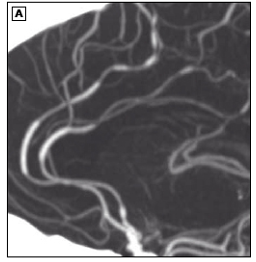RCVS (Reversible Cerebral Vasoconstriction Syndrome)
Background
- Recurrent thunderclap headache, ±seizures, ±strokes
- Transient, reversible dysregulation of cerebral arterial tone with multifocal areas of cerebral vasoconstriction and dilation
- Middle age
- F > M
Clinical
Symptoms
- Recurring thunderclap headache
- ± seizures
- ± strokes:
- Infarcts 10%
- Subcortical SAH (25%)
- DDx SAH in recurring thunderclap
Precipitating
- Sex
- Vigorous exercise
- Pregnancy
- Drugs – e.g. cocaine, MDMA, cannabis
- Vasoactive – SSRIs, nasal decongestants
- Immunosuppressive agents or blood products
- Hypercalcaemia
Differential Dx
| |
RCVS |
Primary CNS Vasculitis |
| CT |
Often normal initially |
Often normal initially |
| MRI |
Often normal initially |
Mostly abnormal initially |
| CSF |
Often normal, some ↑WBCs |
↑WBCs, ↑protein |
| Onset |
Abrupt |
Insidious |
Investigations
- CT often normal
- MRI often normal (early)
- CTA may be normal (early)
- Vasoconstriction/dilation progresses distal to proximal
- Clasical CTA "sausages on a string" may appear late
Management
- Analgesia
- Remove precipitans (e.g. cocaine/SSRIs)
- Ca2+ channel blockers
- Nimodipine 60mg orally every 6 hours or 1.2 mg/kg/hour IV
- Triptans are contra-indicated
Prognosis
- Good
- CTA vasospasm normalises over time
- Most make a complete recovery without recurrence
Content by Dr Íomhar O' Sullivan. Last review DrÍOS 25/09/24.
